Two Castles at Aston,
Herefordshire
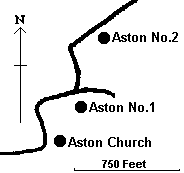 The two castles at Aston stand roughly half way between the centres of two
baronies, four miles to the west of Wigmore and three miles to the east of
Ludlow. It is unusual to have two castles so closely sited and when this does
happen one is often more powerful than the other. This is certainly true of the
two castles at Aston and it would appear here, as at similar sites, that the
weaker fortress was the siege castle of the stronger. To suggest when these
castles were built it is first necessary to look at the tenurial history of the
vill of Aston.
The two castles at Aston stand roughly half way between the centres of two
baronies, four miles to the west of Wigmore and three miles to the east of
Ludlow. It is unusual to have two castles so closely sited and when this does
happen one is often more powerful than the other. This is certainly true of the
two castles at Aston and it would appear here, as at similar sites, that the
weaker fortress was the siege castle of the stronger. To suggest when these
castles were built it is first necessary to look at the tenurial history of the
vill of Aston.
It is recorded in the Domesday Book of 1086 that Aston (Hesintune) was
held in demesne by Ralph Mortimer of Wigmore. Previously the vill had been held
by five men as three separate manors. In 1086 it consisted of three hides which
paid tax. In these lands were two ploughs, five villagers and two smallholders
with three additional ploughs between them. Domesday also records that before
the coming of William the Conqueror in 1066 the land was waste, but it had
recovered by 1086 to the value of 30 shillings. It would seem likely that at
some point before 17 August 1252 one of the Mortimers granted Aston to one of
the Bramptons of Brampton Bryan. On 17 August 1252 the king granted Brian
Brampton free warren in Brampton Bryan, Bucton, Stanage, Weston and Pittes
in Shropshire, as well as Aston in Herefordshire and Waunton in Somerset. Also,
sometime in the reign of King Henry III (1216-72) Brian Brampton (1221-77) made
an exchange for lands in Aston by a charter which has survived in the British
Library as Sloane xxxii, 18. We can adjudge from this that the vill of Aston, or
at least parts of it, were sub-enfeoffed by the Mortimers to the Bramptons
sometime between 1087 and 1252. It is unfortunate that the Mortimer barony of
Wigmore was never subject to royal inquisition during the early Middle Ages
mainly due to the treaty agreed between Hugh Mortimer and King Henry
II on 7
July 1155 at Bridgnorth. This treaty ended the civil war of King Stephen’s
reign and, as we will see below, may throw some light on the foundation and
history of Aston during the time known as the Anarchy (1136-1154).
The male line of Brampton of Brampton Bryan died out in 1294 and Aston
appears to have passed to the hands of the Birley family. Certainly Aston is
next mentioned in 1305 when it was found by inquisition that John Birley held
one knight's fee in Aston, Ashford Jones and Kinton and a further fee in Birley.
All of these were held from the lord of Wigmore. Earlier, in 1243 and 1256, John’s
ancestor Simon Birley was only recorded as lord of Birley and Ashford Jones.
This of course fits well with the Bramptons holding the vill until 1294. By 1361
another John Birley seems to have further extended his estates by adding the
Mortimer land of Kinton to his fees. In the 1361 inquisition he was recorded as
holding 1a fees in Aston, Ashford and
Kinton and a further fee at Birley. This would suggest that Ashford and Kinton
were acquired from the Mortimers in the late thirteenth or early fourteenth
century, while Aston probably came to them either through exchange with the
Bramptons or by marriage. We therefore have a reasonable if hazy idea of the
honorial holders of Aston vill during the ages when motte and bailey castles
were built.
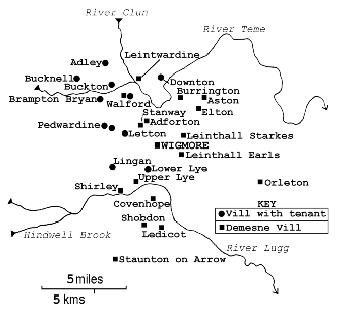 If the tenurial history outlined above is correct it is possible that any
castle at Aston was the work of the Mortimer lords themselves. During the
Anarchy of King Stephen's reign Hugh Mortimer of
Wigmore was recorded as being
at war with Joyce Dinan of Ludlow some time between 1139 and 1148. Dinan, though
originally a protégée of the king, had become an enemy of the royalists who
supported King Stephen (1135-54). These royalists included Hugh Mortimer,
William Braose of Radnor and Osbern Fitz Hugh of Richard's
Castle. After 1144
Gilbert Lacy and his allies who included Hugh Mortimer, attacked Joyce in Ludlow
castle after Dynan gate towards the river had been opened. During the attack a
tower over the gate was burnt and the keep (high tower) largely overthrown.
After reaching this low point in his career, Joyce began to fight his way back.
Soon after 1148 Sir Hugh Lacy of Longtown (d.1186), a great friend of Hugh Mortimer, advised
him that the new abbey he was building for the Shobdon monks at Lye near
Aymestrey could be made use of by an enemy if captured. Mortimer at this time
was surrounded by enemies and there was a great hostility towards him.
Consequently he accepted his friend's advice and demolished the unfinished
church, moving the monks to Wigmore. Mortimer then so pertinaciously pursued his
war against the Angevins that Joyce Dinan was not able to move about his lands
freely. At this point Joyce contrived to capture Hugh when he was virtually
unattended and the lord of Wigmore was later ransomed for 3,000 marks of silver,
all his silver plate, his horses and hunting birds.
If the tenurial history outlined above is correct it is possible that any
castle at Aston was the work of the Mortimer lords themselves. During the
Anarchy of King Stephen's reign Hugh Mortimer of
Wigmore was recorded as being
at war with Joyce Dinan of Ludlow some time between 1139 and 1148. Dinan, though
originally a protégée of the king, had become an enemy of the royalists who
supported King Stephen (1135-54). These royalists included Hugh Mortimer,
William Braose of Radnor and Osbern Fitz Hugh of Richard's
Castle. After 1144
Gilbert Lacy and his allies who included Hugh Mortimer, attacked Joyce in Ludlow
castle after Dynan gate towards the river had been opened. During the attack a
tower over the gate was burnt and the keep (high tower) largely overthrown.
After reaching this low point in his career, Joyce began to fight his way back.
Soon after 1148 Sir Hugh Lacy of Longtown (d.1186), a great friend of Hugh Mortimer, advised
him that the new abbey he was building for the Shobdon monks at Lye near
Aymestrey could be made use of by an enemy if captured. Mortimer at this time
was surrounded by enemies and there was a great hostility towards him.
Consequently he accepted his friend's advice and demolished the unfinished
church, moving the monks to Wigmore. Mortimer then so pertinaciously pursued his
war against the Angevins that Joyce Dinan was not able to move about his lands
freely. At this point Joyce contrived to capture Hugh when he was virtually
unattended and the lord of Wigmore was later ransomed for 3,000 marks of silver,
all his silver plate, his horses and hunting birds.
It was probably during this unsettled period that the first and major Aston
castle, known as Aston No.1, was built. The Mortimers, with their main castles
at Wigmore, Dinieithon and Cleobury, would seem unlikely to have built a castle
in the secure Aston manor at an early period. This minor holding lay a long way
from any military threat before 1136 and was not an early castle site which
supported their main fortress at Wigmore. In 1138 a general war began in
Herefordshire and spread eastwards as lawlessness gripped England. In 1139 Miles
Gloucester joined Gilbert Lacy in rebellion in Herefordshire and Shropshire
bringing much instability to the region. Hugh Mortimer took the part of King
Stephen against the rebels who fought for the legitimate cause of the Empress
Matilda of Germany. The war had come to an end by 1150 when Hugh Mortimer had
made his peace with the rebels. It would also seem unlikely that the siege
castle, Aston No.2, dates to after October 1154 when Henry II (1154-89) came to
the throne and peace returned to England. In the spring of 1155 Hugh Mortimer
and Earl Roger of Hereford joined forces and rebelled against the new king.
Henry II was forced to march against them with the feudal host of England. Earl
Roger quickly capitulated, but Hugh was made of sterner stuff. The three
Mortimer castles of Wigmore, Cleobury Mortimer and Bridgnorth were recorded as
being besieged. These sieges continued for three long months and during that
time Cleobury castle was destroyed. It would seem likely that to achieve his
victory the king resorted to building siege castles at all three sites. Two
castles were built to blockade Wigmore, one to the north and one to the south of
Wigmore castle itself, commanding both entrances to the fortresses. Castle Toot
was possibly built above Cleobury castle and Panpudding Hill, originally founded
by Henry I in 1102, was put back into action at Bridgnorth. After a ferocious
resistance Hugh Mortimer made his peace with King Henry II on 7 July 1155 at a
great council at Bridgnorth.
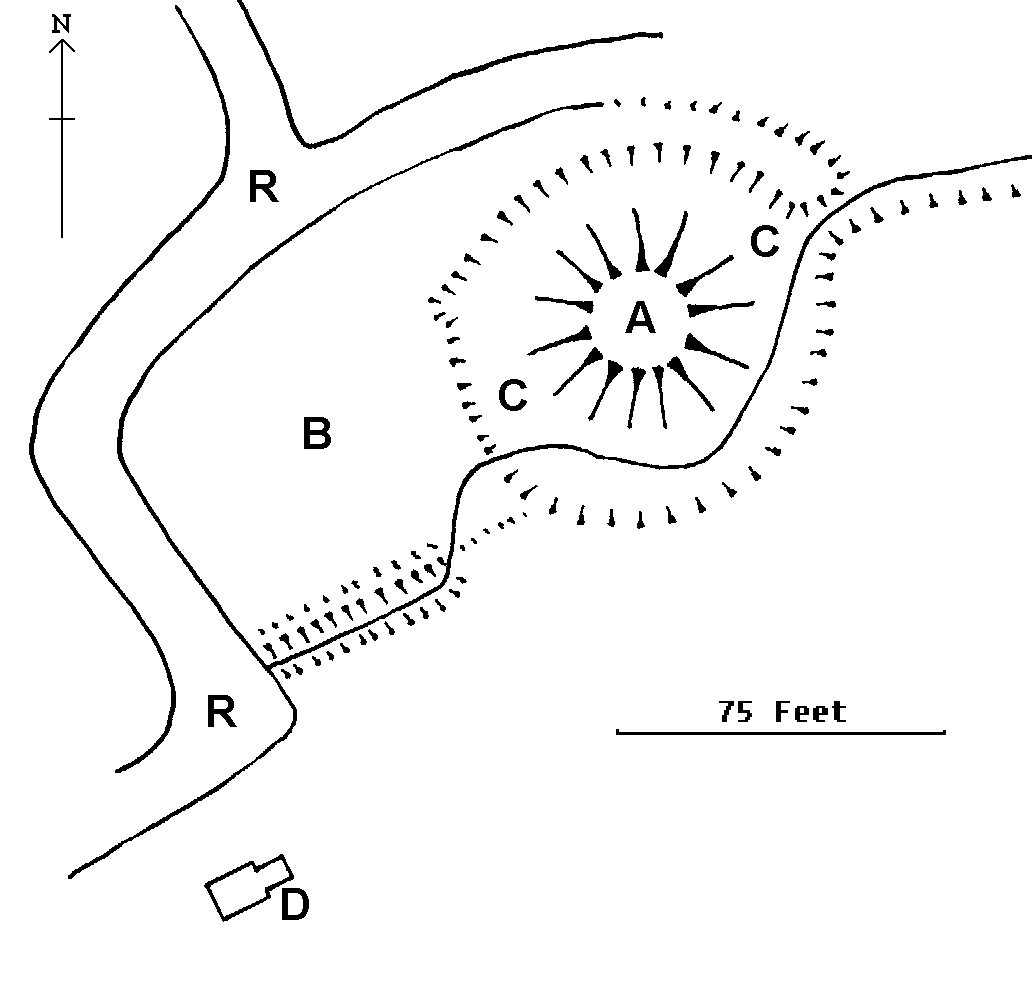 The forces brought to bear by Henry against Hugh Mortimer show several
things. The strength of Wigmore and Bridgnorth, which the king failed to take
after three months of arduous siege, and the strength of Mortimer, whom Henry II
held in a lifetime's distaste, but of whom he could not rid himself. An attack
in such force against Aston No.1 would probably have been using a sledgehammer
to crack a little nut and it is doubtful if this castle was victualled against
the Crown. Bishop’s Castle, which was also held by Mortimer at this time, was
not besieged and there is no evidence that the other minor Mortimer castles -
Downton on the Rock, Upper and Lower Lingen, Lower Lye, Walford, Buckton,
Bucknell, Brampton Bryan and Upper and Lower Pedwardine - were besieged. Aston
No.1 is not a castle 'to laugh a siege to scorn'. Further the apparent siege
castle at Aston No.2 does not seem to be on the same scale as those found around
Wigmore, Cleobury and Bridgnorth. Of course its lesser size could be interpreted
as proportional to the lesser threat of Aston castle. From what evidence there
is it would seem best to interpret Aston No.2 as a baronial siege castle of the
mid 1140's to early 1150's, possibly built by Joyce Dinan to besiege Hugh
Mortimer’s relatively recent castle of Aston No.1.
The forces brought to bear by Henry against Hugh Mortimer show several
things. The strength of Wigmore and Bridgnorth, which the king failed to take
after three months of arduous siege, and the strength of Mortimer, whom Henry II
held in a lifetime's distaste, but of whom he could not rid himself. An attack
in such force against Aston No.1 would probably have been using a sledgehammer
to crack a little nut and it is doubtful if this castle was victualled against
the Crown. Bishop’s Castle, which was also held by Mortimer at this time, was
not besieged and there is no evidence that the other minor Mortimer castles -
Downton on the Rock, Upper and Lower Lingen, Lower Lye, Walford, Buckton,
Bucknell, Brampton Bryan and Upper and Lower Pedwardine - were besieged. Aston
No.1 is not a castle 'to laugh a siege to scorn'. Further the apparent siege
castle at Aston No.2 does not seem to be on the same scale as those found around
Wigmore, Cleobury and Bridgnorth. Of course its lesser size could be interpreted
as proportional to the lesser threat of Aston castle. From what evidence there
is it would seem best to interpret Aston No.2 as a baronial siege castle of the
mid 1140's to early 1150's, possibly built by Joyce Dinan to besiege Hugh
Mortimer’s relatively recent castle of Aston No.1.
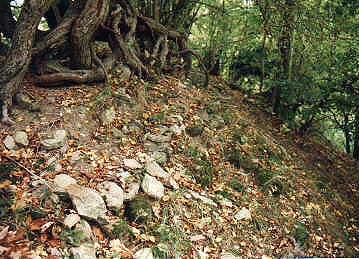 Aston No.1 motte (A) consists of a typical castle mound some 30' high. It
is still surrounded by a mostly damp and periodically flooded moat (C). The
octagonal motte (A) top is about 50' across and to the south are the
foundations of what would appear to have been one side of an octagonal tower
keep, probably similar to the one found at nearby Richards
Castle. The motte
slopes have much loose stone tumbled down the sides and into the moat. The
implication from the above is that Aston No.1 consisted of a stone tower on a
motte, which probably dates to the Anarchy or slightly earlier. To the west of
the motte (A) and its encircling moat (C), is a roughly rectangular field
bounded by a short, but steep drop to the road (R) to east and north, and by a
stream which feeds off the motte moat (C) to the south. This was undoubtedly the
castle bailey (B), though it is now much denuded. The stream to the south of the
bailey (B) has been diverted in recent times and this has cut into the old
bailey rampart showing that it is made up primarily of a stream washed gravel. A
farm track also bisects the bailey (B) north to south close by the motte (A).
This has resulted in the lowering of the bailey bank to the east, while the road
which circumnavigates the bailey to north and west has apparently completely
destroyed any bailey bank and ditch on this front. Entrance to the bailey (B)
was probably to the north as the suggested siege castle covers this side of the
fortress. There its fire could impede soldiers entering or leaving Aston No.1.
This would surely have been a primary responsibility of the besiegers in Aston
No.2.
Aston No.1 motte (A) consists of a typical castle mound some 30' high. It
is still surrounded by a mostly damp and periodically flooded moat (C). The
octagonal motte (A) top is about 50' across and to the south are the
foundations of what would appear to have been one side of an octagonal tower
keep, probably similar to the one found at nearby Richards
Castle. The motte
slopes have much loose stone tumbled down the sides and into the moat. The
implication from the above is that Aston No.1 consisted of a stone tower on a
motte, which probably dates to the Anarchy or slightly earlier. To the west of
the motte (A) and its encircling moat (C), is a roughly rectangular field
bounded by a short, but steep drop to the road (R) to east and north, and by a
stream which feeds off the motte moat (C) to the south. This was undoubtedly the
castle bailey (B), though it is now much denuded. The stream to the south of the
bailey (B) has been diverted in recent times and this has cut into the old
bailey rampart showing that it is made up primarily of a stream washed gravel. A
farm track also bisects the bailey (B) north to south close by the motte (A).
This has resulted in the lowering of the bailey bank to the east, while the road
which circumnavigates the bailey to north and west has apparently completely
destroyed any bailey bank and ditch on this front. Entrance to the bailey (B)
was probably to the north as the suggested siege castle covers this side of the
fortress. There its fire could impede soldiers entering or leaving Aston No.1.
This would surely have been a primary responsibility of the besiegers in Aston
No.2.
Some 700' to the north of Aston No.1 is a much denuded 'ringwork' (R) and
bailey (W), now known as Aston No.2. Dr Allan Peacey, who is excavating near
Aston No.2, reported that immediately west of the castle, twelve pottery shards
had been found in a spoil site. They dated from the period between the eleventh
and sixteenth century. This may only mark occupation debris from the village and
may not be concerned at all with either castle, but the find is useful in
indicating activity in the district from an early date.
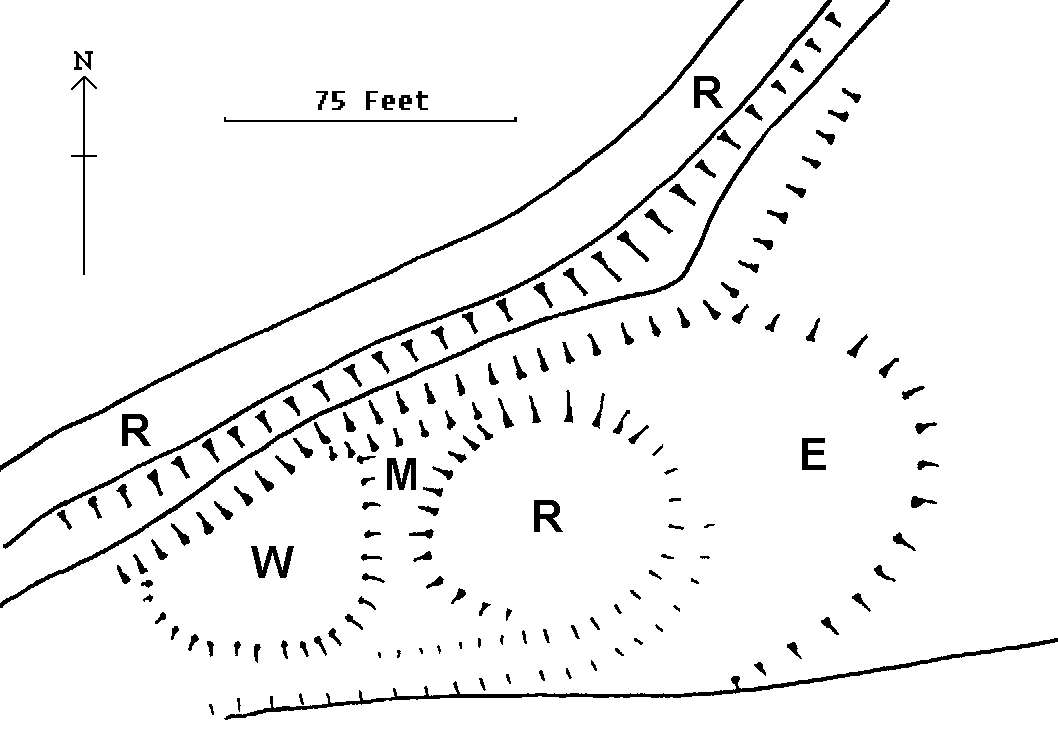 Aston castle No.2 consists of a low, ditched 'ringwork' (R) about 75'
across, much destroyed to the south and east. The ditch (M) which is best
preserved to the north is only a few feet deep and the scarp of the mound behind
it is only about five feet above the ditch bottom. To the south the mound has
been mostly ploughed out, but a good green crop mark of the ditch's original
position is often apparent. A stream running between the mound and the metalled
road (R) to the north provides a steep sided gully which protected this front
from attack. The weak and irregular bailey (W) seems to have lain towards Aston
motte (A) some 700' to the SE. This too has been heavily denuded to
the south. There is also a possible bailey (E) to the east. The flimsiness and
lack of masonry at Aston No.2 would seem to leave little room for doubt that
this was the siege castle of Aston No.1 and not the other way around. Aston No.2
is therefore quite likely to be one of the 1,115 castles recorded as destroyed
by Henry II in the aftermath of the Anarchy. Aston No.1 may also date to this
period and may also have suffered the same fate, after all a castle here would
have been of little strategic interest to the Mortimers when their friends and
allies were once again installed in Richards Castle and Ludlow.
Aston castle No.2 consists of a low, ditched 'ringwork' (R) about 75'
across, much destroyed to the south and east. The ditch (M) which is best
preserved to the north is only a few feet deep and the scarp of the mound behind
it is only about five feet above the ditch bottom. To the south the mound has
been mostly ploughed out, but a good green crop mark of the ditch's original
position is often apparent. A stream running between the mound and the metalled
road (R) to the north provides a steep sided gully which protected this front
from attack. The weak and irregular bailey (W) seems to have lain towards Aston
motte (A) some 700' to the SE. This too has been heavily denuded to
the south. There is also a possible bailey (E) to the east. The flimsiness and
lack of masonry at Aston No.2 would seem to leave little room for doubt that
this was the siege castle of Aston No.1 and not the other way around. Aston No.2
is therefore quite likely to be one of the 1,115 castles recorded as destroyed
by Henry II in the aftermath of the Anarchy. Aston No.1 may also date to this
period and may also have suffered the same fate, after all a castle here would
have been of little strategic interest to the Mortimers when their friends and
allies were once again installed in Richards Castle and Ludlow.
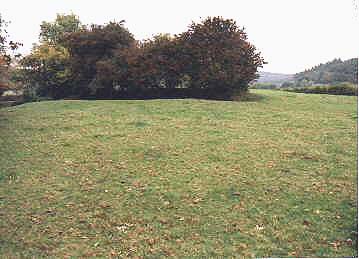 A final point about the provenance of Aston castles might be deduced from the
church. Aston church (D) is rightly known for its fine tympanum and decorated
chevron arch. However it should also be noted that the top of the door is
chamfered. A similar, but more complex arrangement can be seen at nearby Yatton
chapel. This similarity of design might suggest a common patron. Initially such
a patron might be sought from the ranks of the Mortimer family. However between
1119/27 and 1137 Wigmore barony and its appurtenant lands were apparently in the
hands of Pain Fitz John, Henry I's able lieutenant. Rowlestone church in Ewias
also has a fine tympanum set in a decorated archway. Pain Fitz John also held
Ewais Lacy barony. Pain also held Shobdon as an appurtenance of Wigmore. The
fine carvings of Shobdon priory are still to be seen built into a folly
overlooking Shobdon castle and church. Therefore the possibility that Pain, a
very rich royal official, was influential in the so-called Shobdon school of architecture,
and may also have been responsible for Aston castle No.1, should not be
overlooked.
A final point about the provenance of Aston castles might be deduced from the
church. Aston church (D) is rightly known for its fine tympanum and decorated
chevron arch. However it should also be noted that the top of the door is
chamfered. A similar, but more complex arrangement can be seen at nearby Yatton
chapel. This similarity of design might suggest a common patron. Initially such
a patron might be sought from the ranks of the Mortimer family. However between
1119/27 and 1137 Wigmore barony and its appurtenant lands were apparently in the
hands of Pain Fitz John, Henry I's able lieutenant. Rowlestone church in Ewias
also has a fine tympanum set in a decorated archway. Pain Fitz John also held
Ewais Lacy barony. Pain also held Shobdon as an appurtenance of Wigmore. The
fine carvings of Shobdon priory are still to be seen built into a folly
overlooking Shobdon castle and church. Therefore the possibility that Pain, a
very rich royal official, was influential in the so-called Shobdon school of architecture,
and may also have been responsible for Aston castle No.1, should not be
overlooked.
The
Mortimers of Wigmore, 1066 to 1181. Part
1: Wigmore Castle (ISBN 1-899376-14-3) [1995] looks in
detail at the first
three English Mortimers, Roger, Ralph and Hugh (d.1181) and their
Norman
predecessors. The foundation and design of Wigmore castle by
William Fitz Osbern around 1070 is examined and also the setting up of
the
associated castellany which later became the Mortimer honour of
Wigmore. The
castle is then explored and explained with many photographs taken
before the recent
English Heritage repair work at the site. Two possible 'siege castles'
are also
described with reference to the present stately pile and its probable
construction dates.
Order The Mortimers of Wigmore, 1066
to 1181 for
£9.95 through the PayPal
basket below.
Copyright©1994-2007
Paul Martin Remfry
 The two castles at Aston stand roughly half way between the centres of two
baronies, four miles to the west of Wigmore and three miles to the east of
Ludlow. It is unusual to have two castles so closely sited and when this does
happen one is often more powerful than the other. This is certainly true of the
two castles at Aston and it would appear here, as at similar sites, that the
weaker fortress was the siege castle of the stronger. To suggest when these
castles were built it is first necessary to look at the tenurial history of the
vill of Aston.
The two castles at Aston stand roughly half way between the centres of two
baronies, four miles to the west of Wigmore and three miles to the east of
Ludlow. It is unusual to have two castles so closely sited and when this does
happen one is often more powerful than the other. This is certainly true of the
two castles at Aston and it would appear here, as at similar sites, that the
weaker fortress was the siege castle of the stronger. To suggest when these
castles were built it is first necessary to look at the tenurial history of the
vill of Aston. If the tenurial history outlined above is correct it is possible that any
castle at Aston was the work of the Mortimer lords themselves. During the
Anarchy of King Stephen's reign Hugh Mortimer of
Wigmore was recorded as being
at war with Joyce Dinan of Ludlow some time between 1139 and 1148. Dinan, though
originally a protégée of the king, had become an enemy of the royalists who
supported
If the tenurial history outlined above is correct it is possible that any
castle at Aston was the work of the Mortimer lords themselves. During the
Anarchy of King Stephen's reign Hugh Mortimer of
Wigmore was recorded as being
at war with Joyce Dinan of Ludlow some time between 1139 and 1148. Dinan, though
originally a protégée of the king, had become an enemy of the royalists who
supported  The forces brought to bear by Henry against Hugh Mortimer show several
things. The strength of Wigmore and Bridgnorth, which the king failed to take
after three months of arduous siege, and the strength of Mortimer, whom Henry II
held in a lifetime's distaste, but of whom he could not rid himself. An attack
in such force against Aston No.1 would probably have been using a sledgehammer
to crack a little nut and it is doubtful if this castle was victualled against
the Crown. Bishop’s Castle, which was also held by Mortimer at this time, was
not besieged and there is no evidence that the other minor Mortimer castles -
Downton on the Rock, Upper and Lower Lingen, Lower Lye, Walford, Buckton,
Bucknell, Brampton Bryan and Upper and Lower Pedwardine - were besieged. Aston
No.1 is not a castle 'to laugh a siege to scorn'. Further the apparent siege
castle at Aston No.2 does not seem to be on the same scale as those found around
The forces brought to bear by Henry against Hugh Mortimer show several
things. The strength of Wigmore and Bridgnorth, which the king failed to take
after three months of arduous siege, and the strength of Mortimer, whom Henry II
held in a lifetime's distaste, but of whom he could not rid himself. An attack
in such force against Aston No.1 would probably have been using a sledgehammer
to crack a little nut and it is doubtful if this castle was victualled against
the Crown. Bishop’s Castle, which was also held by Mortimer at this time, was
not besieged and there is no evidence that the other minor Mortimer castles -
Downton on the Rock, Upper and Lower Lingen, Lower Lye, Walford, Buckton,
Bucknell, Brampton Bryan and Upper and Lower Pedwardine - were besieged. Aston
No.1 is not a castle 'to laugh a siege to scorn'. Further the apparent siege
castle at Aston No.2 does not seem to be on the same scale as those found around
 Aston No.1 motte (A) consists of a typical castle mound some 30' high. It
is still surrounded by a mostly damp and periodically flooded moat (C). The
octagonal motte (A) top is about 50' across and to the south are the
foundations of what would appear to have been one side of an octagonal tower
keep, probably similar to the one found at nearby
Aston No.1 motte (A) consists of a typical castle mound some 30' high. It
is still surrounded by a mostly damp and periodically flooded moat (C). The
octagonal motte (A) top is about 50' across and to the south are the
foundations of what would appear to have been one side of an octagonal tower
keep, probably similar to the one found at nearby  Aston castle No.2 consists of a low, ditched 'ringwork' (R) about 75'
across, much destroyed to the south and east. The ditch (M) which is best
preserved to the north is only a few feet deep and the scarp of the mound behind
it is only about five feet above the ditch bottom. To the south the mound has
been mostly ploughed out, but a good green crop mark of the ditch's original
position is often apparent. A stream running between the mound and the metalled
road (R) to the north provides a steep sided gully which protected this front
from attack. The weak and irregular bailey (W) seems to have lain towards Aston
motte (A) some 700' to the SE. This too has been heavily denuded to
the south. There is also a possible bailey (E) to the east. The flimsiness and
lack of masonry at Aston No.2 would seem to leave little room for doubt that
this was the siege castle of Aston No.1 and not the other way around. Aston No.2
is therefore quite likely to be one of the 1,115 castles recorded as destroyed
by Henry II in the aftermath of the Anarchy. Aston No.1 may also date to this
period and may also have suffered the same fate, after all a castle here would
have been of little strategic interest to the Mortimers when their friends and
allies were once again installed in
Aston castle No.2 consists of a low, ditched 'ringwork' (R) about 75'
across, much destroyed to the south and east. The ditch (M) which is best
preserved to the north is only a few feet deep and the scarp of the mound behind
it is only about five feet above the ditch bottom. To the south the mound has
been mostly ploughed out, but a good green crop mark of the ditch's original
position is often apparent. A stream running between the mound and the metalled
road (R) to the north provides a steep sided gully which protected this front
from attack. The weak and irregular bailey (W) seems to have lain towards Aston
motte (A) some 700' to the SE. This too has been heavily denuded to
the south. There is also a possible bailey (E) to the east. The flimsiness and
lack of masonry at Aston No.2 would seem to leave little room for doubt that
this was the siege castle of Aston No.1 and not the other way around. Aston No.2
is therefore quite likely to be one of the 1,115 castles recorded as destroyed
by Henry II in the aftermath of the Anarchy. Aston No.1 may also date to this
period and may also have suffered the same fate, after all a castle here would
have been of little strategic interest to the Mortimers when their friends and
allies were once again installed in  A final point about the provenance of Aston castles might be deduced from the
church. Aston church (D) is rightly known for its fine tympanum and decorated
chevron arch. However it should also be noted that the top of the door is
chamfered. A similar, but more complex arrangement can be seen at nearby Yatton
chapel. This similarity of design might suggest a common patron. Initially such
a patron might be sought from the ranks of the Mortimer family. However between
1119/27 and 1137 Wigmore barony and its appurtenant lands were apparently in the
hands of
A final point about the provenance of Aston castles might be deduced from the
church. Aston church (D) is rightly known for its fine tympanum and decorated
chevron arch. However it should also be noted that the top of the door is
chamfered. A similar, but more complex arrangement can be seen at nearby Yatton
chapel. This similarity of design might suggest a common patron. Initially such
a patron might be sought from the ranks of the Mortimer family. However between
1119/27 and 1137 Wigmore barony and its appurtenant lands were apparently in the
hands of